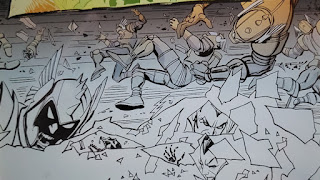In the earlier days of the Marvel Cinematic and DC Expanded Universe and prior to this blog, I wrote columns predicting the members of the Avengers, Justice League and X-Men who were least likely to appear in the movies.
I'm not the best at making predictions, but some of them were pretty solid – at least if you don't count the proliferation of comic-based TV shows. While I have argued “Agents of S.H.I.E.L.D.” and other shows are canon, keeping the Netflix Defenders out of the MCU would at least mean my picks of Hellcat and the Whizzer are still technically correct.
But one I'm fairly confident will stand the test of time is the least likely Justice Leaguer to hit the screen for Warner Bros. whenever they finally decide what to do with the team: Hawkeye.But wait, you might say, Hawkeye's already been in multiple movies. He's starring in a streaming series on Disney+ right now.
I'm well aware. That's why I'm posting this instead of a rundown of “Ravage 2099” #3. But those are Marvel movies.
Right, you'll probably respond. Hawkeye's a Marvel character, so he can't be a member of the Justice League.
But he was. And, unlike most inter-company crossovers, this one's canon.
The long-awaited Avengers-JLA crossover was finally released in 2003, written by Kurt Busiek and drawn by George Perez. Issue 3 opens with the Justice League having trapped Doctor Doom in the Source Wall and the revelation that the League member who sealed the victory was none other than... Hawkeye.
A little expository dialogue from Hawkeye's paramour, Black Canary, reveals he left his own Earth and joined the League, much to the dismay of her ex – or perhaps, in this reality, her never-was – Green Arrow. (Hmm, blond, overconfident archers – Dinah has a type.)
A shift in reality displaces Hawkeye, and we learn that in this new status quo, the Avengers and JLA have regularly teamed up and share an annual holiday party, a nod to classic JLA/JSA crossovers. Their realities have become connected due to the machinations of Krona and the Grandmaster, which is what the teams must sort out over the rest of this issue and the fourth and final installment.
Of the many Marvel and DC characters featured in the crossover, of course it's Hawkeye that jumps realities, however briefly. Despite being a perennial Avenger, he's also the guy who wound up on the Defenders side of the Avengers-Defenders War, took the upstart Great Lakes Avengers under his wing after leaving the West Coast Avengers and did the same years later with the villains-turned-heroes Thunderbolts.
So it's a great touch that's true to the character, but what makes this different from any other inter-company crossover? These stories usually only “exist” in the special issue or series, with no mention or impact in the regular books.
Let's rewind to issue 1, when Krona appears as a disembodied voice and glowing eyes. In his quest to determine the origin of everything, he destroys the Marvel dimension of Polemachus as Arkon and Thundra are starting their day and DC's antimatter universe in the midst of a battle between the Crime Syndicate of America and the Weaponers of Qward.
At one point, there was talk Busiek wanted to try to make the crossover part of the ongoing titles at Marvel and DC, but there proved to be too many legal hurdles.
After writing Avengers for about five years, Busiek penned a multi-part JLA story in 2004-5 called “Syndicate Rules,” drawn by Ron Garney. In JLA #108, the CSA, dark reflections of the league, are shown attacking Qward when something happens.
Their universe ceases to exist but returns with Power Ring, their evil Green Lantern, looking more like John Stewart than the Kyle Rayner analogue who appeared earlier in the issue. The CSA traces the source of the destruction to the positive matter universe.
As the story unfolds, we learn Martian Manhunter has been tracking similar anomalies. And just in case we weren't sure it was the same incident portrayed in JLA/Avengers (I wasn't), in #111, the CSA's Owlman explains that the man responsible for their universe's destruction was Krona and the JLA stopped him – “with some help.”Now, this all happened post-Crisis but pre-Infinite Crisis, which doesn't take into account Flashpoint, Rebirth and whatever the heck happened in Doomsday Clock. But my takeaway from Dark Knights Death Metal was that all the DC stories happened somewhere.
So that means this one is canon and once upon a time, even if only for a couple of pages, Hawkeye was a member of the JLA.








Comments
Post a Comment
No profanity, no bullying, no harassment. Feel free to disagree, but do it respectfully and politely.